Introduction
Eating disorders (EDs) are complex mental health conditions involving persistent disruptions in eating behaviors, body image concerns, and often an intense fear of weight gain. Although they are often seen as affecting primarily young women, an increasing number of men are experiencing eating disorders but remain underdiagnosed and undertreated.
For a long time, cultural stereotypes suggested that men were immune to pressures about weight, appearance, or dieting, but evidence now shows that societal norms, media portrayals, and internal pressures can significantly impact men’s relationships with food and body image.
This article explores the growing prevalence of eating disorders in men, delves into common myths and stigmas about male disordered eating, examines how EDs manifest among males, and outlines pathways for recognition, treatment, and support.
By discussing risk factors, warning signs, and treatment modalities, we can better highlight that male eating disorders are both serious and treatable conditions, worthy of the same level of attention and empathy as those faced by females.
Understanding Eating Disorders
The Types of Eating Disorders
- Anorexia Nervosa (AN): Marked by restricted food intake leading to significantly low body weight, an intense fear of gaining weight, and a distorted self-perception of body shape or size.
- Bulimia Nervosa (BN): Characterized by recurrent binge-eating episodes (consuming large amounts of food in short periods) followed by compensatory behaviors like self-induced vomiting, excessive exercise, or laxative misuse.
- Binge Eating Disorder (BED): Involves episodes of eating large amounts of food, often quickly and to the point of discomfort, accompanied by feelings of guilt or shame but without regular compensatory measures.
- Other Specified Feeding or Eating Disorders (OSFED): Patterns that cause significant distress/impairment but do not meet the full criteria for specific ED diagnoses, e.g., atypical anorexia or purging disorder.
Common Misconceptions
- “Eating Disorders Only Affect Thin, Young Women”: In reality, EDs can occur in all genders, ages, body sizes, and backgrounds. Men may exhibit different outward signs or present with muscle dysmorphia (sometimes called “bigorexia”), complicated by a drive for muscularity.
- “Men with EDs Must Have Another Underlying Condition”: While comorbidities like depression or anxiety are frequent, an eating disorder can arise primarily from body image struggles.
How EDs Develop
- Combination of Biological, Psychological, and Environmental Factors: Genetics, neurotransmitter imbalances, stress, trauma, or cultural ideals can converge.
- Control and Coping: ED behaviors sometimes represent attempts to manage anxiety or negative emotions via controlling food intake or exercise.
Key Insight: Eating disorders in men are not anomalies or less severe. While the specifics of body image concerns may differ from female patients, EDs can pose equally dire physical and psychological consequences for male sufferers.
The Rise of Male Eating Disorders
Shifts in Societal Pressures
- Body Ideals: Advertising and media increasingly showcase lean, muscular male physiques as the “desirable” standard. This fosters dissatisfaction for men who do not match these unattainable images.
- Social Media: Platforms can amplify body comparisons, micro-criticisms, and peer commentary about appearance.
- Fitness Culture: “Bulk and cut” cycles, strict diets, or advanced workout regimens can spiral into disordered patterns if fueled by body image anxieties.
Undercounted Cases in the Past
- Diagnostic Bias: Clinical criteria historically focused on female presentations (e.g., amenorrhea for anorexia), overshadowing men’s experiences. This leads to mislabeled or missed diagnoses.
- Underreporting: Men fear the stigma of having a “women’s disease,” or they may interpret symptoms differently (e.g., “I’m just very disciplined about my fitness.”).
- Evolving Data: Large-scale studies show male representation in ED populations climbing from ~10% in the past to ~25–33% (and possibly more if subclinical forms are included).
Cultural Variations
- Western Societies: Particularly highlight lean or muscular ideals for men.
- Athlete Populations: Sports like wrestling, crew, running, or horse racing intensify body mass regulation pressures.
- Global Patterns: With the globalization of media, more men worldwide adopt these unattainable standards, fueling ED risk.
How Eating Disorders Manifest in Men
Different Symptom Expressions
- Focus on Muscularity: Unlike restricting calories simply to be “thin,” men might engage in compulsive weightlifting, high-protein diets, or performance supplements to appear more muscular.
- Secretive Binge-Purge Cycles: Males may hide binge behaviors or use strenuous exercise instead of vomiting to offset overeating.
- Obsession with “Healthy Eating”: Orthorexia or extreme “clean eating” can escalate, bridging disordered patterns.
Co-Occurring Concerns
- Substance Abuse: Men with EDs sometimes adopt stimulants or anabolic steroids to manipulate weight or muscle mass.
- Body Dysmorphic Disorder: Specifically “muscle dysmorphia,” an intense, unrealistic belief of being too small or weak despite normal or muscular physique.
- Depression and Anxiety: Emotional distress both drives and results from disordered eating cycles, fueling isolation or shame.
Psychological Impact
- Shame and Self-Stigma: Men may feel their struggle is embarrassing or “unmanly.”
- Emotional Isolation: Without peer or familial recognition, they can spiral deeper into ED behaviors unnoticed.
- Risk of Suicidality: EDs carry elevated suicide risks, and men with unresolved mental health concerns are especially vulnerable.
Recognizing Warning Signs in Men
Physical Indicators
- Sudden Weight Change: Significant drop or unusual fluctuations in body mass.
- Gastrointestinal Complaints: Chronic bloating, constipation, or reflux from purging.
- Excessive Exercise: Overtraining, prioritizing workouts above all else, ignoring injuries.
- Signs of Purging: Damaged teeth enamel from vomiting, calluses on knuckles (“Russell’s sign”), frequent bathroom trips post-meals.
Behavioral Changes
- Rigid Food Rules: Cutting out entire food groups or growing more controlling about meal times.
- Social Withdrawal: Avoiding restaurants or gatherings to hide abnormal eating patterns.
- Performance Supplements: Overreliance on protein powders, creatine, or steroids to chase an ideal physique.
Emotional or Psychological Shifts
- Irritability: Restrictive eating can cause low energy, frustration, or mood swings.
- Body Checking: Constantly measuring biceps, weighing daily, fixating on the mirror.
- Defensive or Secretive: Quick to dismiss concerns about new eating or workout habits.
Note: Close friends, family, or coaches might catch these signs earlier than the individual. Early gentle confrontation can prompt reflection and professional help.
Factors Driving Male Eating Disorders
Gender-Specific Pressures
- Masculine Ideals: Media portraying “six-pack abs,” larger arms fosters “drive for muscularity,” fueling disordered behaviors.
- Sports Requirements: Weight-based sports, or performance demands, can push men to adopt extreme diets or bulking/cutting cycles that spiral into ED patterns.
Underlying Vulnerabilities
- Perfectionism: Common across ED subtypes; men with high perfectionism might push boundaries in pursuit of the “perfect body.”
- Trauma/Abuse: Emotional or physical trauma can lead to bodily control attempts through restricted intake or excessive exercise.
- Genetics: Family history of ED or mental health issues can raise predisposition.
Cultural Minimization
- Societal Blind Spots: Healthcare systems historically focusing on female ED fosters fewer male-targeted interventions.
- Male Stereotypes: Hard to imagine men facing “thinness concerns” or admitting “I have an eating disorder,” forging further denial.
Seeking Help: Assessment and Diagnosis
Medical Professionals Involved
- Primary Care Providers: First line to detect physical signs like weight changes, electrolyte imbalances, or GI issues.
- Mental Health Specialists: Psychologists/psychiatrists specifically trained in ED often unravel deeper emotional or cognitive issues fueling behaviors.
- Registered Dietitians: Provide structured meal plans to restore balanced eating, addressing both physical and psychological aspects.
Diagnostic Criteria Adjustments
- DSM-5: Relaxed the emphasis on amenorrhea for anorexia’s definition, making the criteria more inclusive for men.
- Focus on Behavior: Whether restricting, purging, or bingeing, the emphasis is on clinically significant distress or impairment, not gender-specific symptoms.
Screening Tools and Approaches
- ED-Specific Questionnaires: Some validated instruments are adapted for men, focusing on muscle-building obsession or other male concerns.
- Lab Tests: Checking blood counts, electrolytes, hormone levels, EKG if suspicion arises about purging or severe malnutrition.
- Imaging/Bone Density: Chronic malnutrition can lead to osteopenia or osteoporosis in men with prolonged ED, warranting tests.
Treatment Strategies for Men with ED
Psychotherapy Modalities
Cognitive Behavioral Therapy (CBT)
- Core of ED Treatment: Identifies maladaptive thoughts around body image, food, and control. Reframes these into healthier patterns.
- Male Adaptations: Addressing the drive for muscularity or unique masculine stereotypes is crucial for success.
Dialectical Behavior Therapy (DBT)
- Emotion Regulation: Useful if men also struggle with intense mood swings or self-harming urges.
- Mindfulness: Encourages present-focused coping instead of repressive or destructive behaviors.
Nutritional Rehabilitation
- Dietary Counseling: Encouraging normal meal patterns, portion sizes, addressing restrictive rules.
- Muscle Dysmorphia Focus: Some men fixated on building muscle may adopt extreme bulking or cutting diets; experts guide moderate, balanced intakes.
Family Therapy or Group Programs
- Support Systems: Involving partners, parents, or close friends can ease isolation, help men maintain accountability.
- Men-Only Therapy Groups: Provide a comfortable space to share experiences without fear of emasculation or overshadowing by female-centric discussions.
Medical Management
- Medication: Antidepressants (like SSRIs) can help co-occurring depression or bulimic impulses.
- Treating Physical Consequences: Correcting electrolyte imbalances, gastrointestinal issues, or low hormone levels from chronic undernutrition.
- Hospitalization: If dangerously underweight, severe purging, or suicidal risk. Inpatient or partial hospitalization ensures stabilized care.
Addressing Co-Occurring Substance Use
- Dual-Diagnosis: For those mixing stimulants, steroids, or alcohol to manage weight or emotional struggles, integrated substance-abuse and ED care is critical.
Preventive Measures and Awareness
Breaking the Silence in Athletics and Gyms
- Coaches and Trainers: Educating them to spot disordered behaviors, from obsessive calorie counting to overtraining.
- Body-Positive Fitness: Emphasizing strength and health, not only aesthetics. Encouraging rest, balanced diets, and realistic goals.
Men’s Health Campaigns
- Media Representation: Encouraging broader male body imagery in commercials, movies, or fitness publications counters narrow ideals.
- Movember Parallel: Just as Movember addresses men’s mental health and cancer, expansions to ED awareness can further reduce stigma.
Early School Education
- Gender-Neutral ED Education: Teen boys can learn healthy relationships with food, avoiding hyperfocus on “protein mania” or doping.
- Peer Support: Encouraging open dialogues about body dissatisfaction among male teens fosters better identification and early help.
Supporting a Male Loved One with ED
Recognizing Denial or Secrecy
- Gentle Encouragement: Approach concerns without judgment, highlighting observed changes.
- Suggest Professional Help: Offering to accompany them or assist with scheduling can reduce barriers.
Non-Accusatory Conversations
- Use “I” Statements: “I’ve noticed you seem stressed about meals” rather than “You have an eating disorder.”
- Emphasize Concern: Communicate from a place of caring, not confrontation or blame.
Being Part of Recovery
- Positive Reinforcement: Applaud healthy eating or balanced exercise choices.
- Learn about ED: Understanding the complexities helps avoid inadvertently encouraging disordered behaviors (e.g., praising extreme diets).
Long-Term Recovery and Outlook
Resilience and Relapse Prevention
- On-Going Therapy: Periodic check-ins with therapists or dietitians can guard against relapse.
- Healthy Coping Skills: Recognizing emotional triggers that might revert them to old patterns fosters lasting recovery.
Maintaining a Balanced Approach to Fitness
- Moderate Goals: Setting realistic strength or fitness targets, avoiding extremes in body composition pursuits.
- Integrating Pleasure: Encouraging men to enjoy movement or sports for fun, not just for aesthetic outcomes.
Shaping Future Perspectives
- Evolving Masculinity: The more men speak about mental health and body image, the more society can shift away from narrow, harmful norms.
- Family and Generational Change: Fathers or older male role models who address ED openly teach younger men that vulnerability is strength.
Bottom Line: With comprehensive, empathic treatment and supportive communities, men can overcome eating disorders, regaining healthier relationships with food, exercise, and themselves.
Conclusion
Though historically underrecognized, male eating disorders are undeniably on the rise. Societal pressures, a push for leanness or hyper-muscularity, and reluctance to seek emotional support create a “perfect storm” for disordered eating patterns in men. From high school athletes restricting calories to older men punishing themselves in the gym, the manifestations vary, but the core issues—low self-esteem, body dissatisfaction, or emotional turmoil—remain consistent.
Encouraging men to observe their relationship with food, body image, and exercise is critical, as is educating health providers to detect male-centric signs. Friends, family, and sports coaches must be attuned to warning signals, while specialized therapy, nutritional counseling, and occasionally medication can facilitate recovery. By validating that “men get eating disorders, too,” we open pathways for healing and reduce the stigma that typically hinders men from seeking life-changing—and lifesaving—help.
References
- Mitchison D, Mond J, Slewa-Younan S, et al. The prevalence and impact of eating disorder behaviours in 15-year old Australians. BMC Public Health. 2020;20:408.
- Raevuori A, Keski-Rahkonen A, Hoek HW. A review of eating disorders in males. Curr Opin Psychiatry. 2014;27(6):426-430.
- Darcy AM, Lin IH, Brown TA. The eating disorders examination in male athletes: a systematic review. Body Image. 2016;18:62-68.
- Rosen DS. Identification and management of eating disorders in children and adolescents. Pediatrics. 2010;126(6):1240-1253.
- American Psychiatric Association. Diagnostic and Statistical Manual of Mental Disorders (DSM-5). 5th ed. Washington, DC: APA; 2013.
- Grilo CM, Reas DL, Mitchell JE. Combining medication and psychological treatments for binge eating disorder. J Psychiatr Pract. 2016;22(3):278-287.
- Murray SB, Nagata JM, Griffiths S, et al. The enigma of male eating disorders: A critical review and research agenda. Nutrients. 2017;9(10):1022.
- Olivardia R. Hidden faces of eating disorders in men. Psychiatr Clin North Am. 2021;44(2):301-312.
- Nagata JM, Gorrell S, Mitchison D, et al. Disordered eating behaviors and muscle-enhancing behaviors in adolescents and young adults. J Adolesc Health. 2020;66(5):519-528.
- Thomas JJ, Lee S, Becker AE. Updates in the classification of eating disorders. Curr Opin Psychiatry. 2016;29(6):340-349.
- Treasure J, Stein D, Maguire S. Has the time come for a stricter definition of anorexia nervosa? Nat Rev Dis Primers. 2015;1:15074.
- Richardson C, Patton GC. The emergence of eating disorders in men: signs, symptoms, and significance. Curr Opin Psychiatry. 2020;33(4):443-448.
- Blashill AJ. Gender roles, body image, and eating-related behaviors. Psychol Men Masc. 2020;21(1):14-20.
- Griffiths S, Hay P, Mitchison D, et al. Sex differences in the relationships between body dissatisfaction, quality of life and psychological distress. Body Image. 2016;17:86-92.





